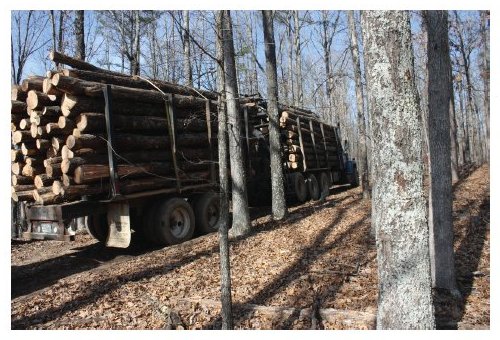AgEBB-MU CAFNR Extension
Green Horizons
Volume 20, Number 2
May 2016
Forest Industry
Blocking Wood Products: Commonplace in the Ozarks But Not Statewide
By JASON GREEN | Pioneer Forest LLC
To a forester, tree utilization is a very important aspect of a logging job. Better utilization of trees often equates to a cleaner looking logging job and potentially more stumpage for the landowner. In particular, any commercial use of low quality, small diameter trees should serve as an enhancement. In the Ozarks, blocking is sold on a daily basis. It is not in the northern and central part of the state and one might wonder why.
First of all, what is blocking and stumpage? Blocking, as it is called in the Ozarks, generally refers to using small diameter, low quality logs that typically are sawn into pallet lumber. Blocking is not used in such products as flooring or cabinets. Blocking products usually are harvested as individual trees that are less than 11 inches in diameter at breast height (DBH) or as logs that are cut out of the tops of more valuable sawlog trees. Blocking can be utilized down to a 4-inch small end diameter in some cases. Stumpage refers to the value of a tree on the "stump" (i.e., standing), that will be paid to the landowner. Stumpage is most often expressed in dollars per thousand board feet or in dollars per ton.
 |
Small diameter blocking logs loaded and ready to be delivered to a "scrag" mill. Photo credit: Jason Green |
Selling blocking in the Ozarks is common. Most mills will saw blocking and they generally have good markets for their products. In fact, there are several mills that specialize in selling only pallet lumber from blocking logs. These specialty blocking mills, or "scrag" mills as they are often called, generally buy their logs by the tree length and pay on a per ton basis. Generally, landowners in the Ozarks can expect to get between $8 and $10 per ton stumpage for blocking. Depending on the size of the sale, the additional income can be significant. For example, let's assume that a forester sold timber in which he estimated that there were 50,000 board feet (bf) in sawlogs (sawlogs are larger, higher quality logs that are used for cabinet lumber, flooring, and railroad ties and bring much higher prices than blocking). Upon the request of the forester, the logger is asked to sort and merchandize blocking logs and sawlogs separately. The forester has negotiated a price for sawlogs at $220 per thousand board feet ($36.67 per ton) and blocking logs at $60 per thousand board feet ($10 per ton). The landowner receives $11,000 for the sawlogs alone. While it might sound far-fetched, the blocking products from small logs and logs cut out of the tops of sawlog trees can easily increase the total volume of the sale by as much as 40%. It all comes down to good tree utilization. In the case of the landowner above, he would get paid for an additional 20,000 board feet of blocking. Assuming the price of $60 per thousand for 20,000 board feet, the landowner would receive an additional $1200 ($0.06 X 20,000 bf = $1200).
So why doesn't this work outside of the Ozarks in other parts of the state? There are likely several reasons. One is the availability of timber resources. The Ozarks has the highest density of timberland in the state of Missouri. Loggers don't have to go far to find timber to buy. In other parts of the state, timberland is more widely spread and loggers often must travel farther to find it. Another reason is likely economics. The central and northern parts of the state have far fewer sawmills than are found in the Ozarks. So when a logger buys timber, he may have to haul it farther which increases his logging costs. There are real limits on what is economical for a logger to cut and haul. Furthermore, there are very few pallet lumber mills in other regions of the state, so hauling blocking becomes a major issue for loggers in those regions. A final reason is culture and tradition. Small diameter timber is very difficult and, in many cases, impossible to sell in the northern and central parts of the state. Part of the problem could be related to the tradition of using the Doyle scale (vs International ¼ Inch in the Ozarks) which tends to give poorer volume estimates on small diameter timber The Doyle and International scales are rules used to estimate the number of board feet in logs based upon their diameter and length. Selling blocking by weight, however, could alleviate this issue. Cutting and hauling blocking in the Ozarks has been on-going for decades, but the Ozarks has a different forestry culture and tradition from other areas of the state.
There are probably opportunities for blocking mills in some locations in the northern and central parts of Missouri. Individuals thinking about beginning a blocking mill will undoubtedly have some challenges and will need to be especially strategic in their location of operation. However, establishment of a few mills would provide landowners, loggers, and foresters with more options for utilizing the timber resource and would increase the income from landowner's sales.
